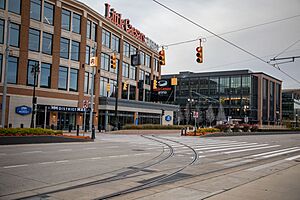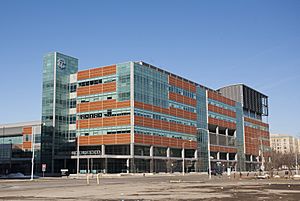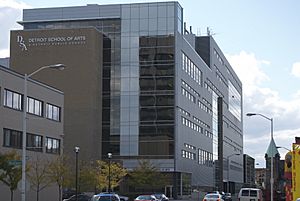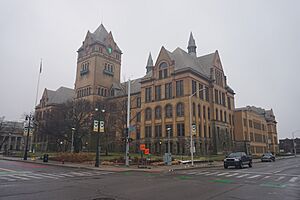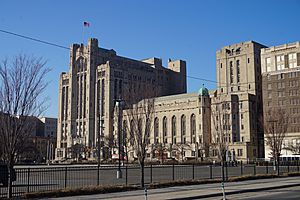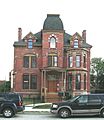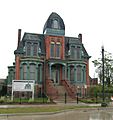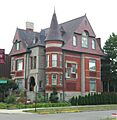Midtown Detroit facts for kids
Quick facts for kids
Midtown Detroit
|
|
|---|---|
|
Cultural center and neighborhood
|
|
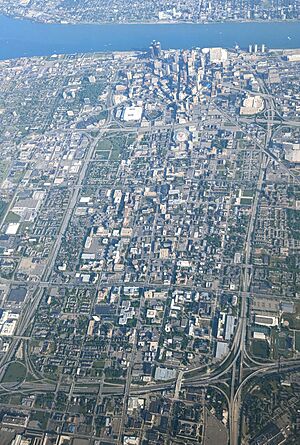
Midtown Detroit encircled by freeways
|
|
| Country | |
| State | |
| County | |
| City | |
| Area | |
| • Total | 5.4 km2 (2.09 sq mi) |
| • Land | 5.4 km2 (2.09 sq mi) |
| • Water | 0 km2 (0.00 sq mi) |
| Population
(2010)
|
|
| • Total | 14,550 |
| • Density | 2,687.77/km2 (6,961.28/sq mi) |
| Time zone | UTC-5 (Eastern Standard Time (North America)) |
| • Summer (DST) | UTC-4 (Eastern Daylight Time (North America)) |
Midtown Detroit is a busy area in Detroit, Michigan. It has both businesses and homes. You can find it along Woodward Avenue, just north of Downtown Detroit.
Midtown is known for its many historic districts. It's home to about 14,550 people and covers about 2.09 square miles. Major highways like the Chrysler Freeway (I-75) and the Lodge Freeway (M-10) form its borders.
| Top - 0-9 A B C D E F G H I J K L M N O P Q R S T U V W X Y Z |
Exploring Midtown Detroit
Midtown is a lively area with different neighborhoods. It has changed a lot over time. The main street, Woodward Avenue, runs right through the middle. This area used to be called Cass Corridor. Many people in Detroit still use that name.
Woodward Avenue is full of shops, cultural places, and churches. The main cultural attractions, like the Detroit Public Library and the Detroit Institute of Arts, are right on Woodward.
Wayne State University: A Hub of Learning
A big part of Midtown, especially west of Woodward Avenue, is taken up by Wayne State University. This university covers about 203 acres. It's one of Michigan's top research schools. Over 32,000 students attend Wayne State.
The university started small in 1868 as the Detroit Medical College. Over the years, more schools joined. In 1933, they all came together as Wayne University. In 1956, it became Wayne State University. Since the 1940s, the university has helped shape the area around it. It has built new buildings and fixed up old ones.
The Art and Cultural Center
The Art Center, also called the Cultural Center, is a special part of Midtown. It includes the Cultural Center Historic District. Here you'll find the Detroit Public Library, the Detroit Institute of Arts, and the Horace H. Rackham Education Memorial Building.
The library and art museum were built in the 1920s. This helped make Woodward Avenue a cultural center for Detroit. Other important places joined them, like the Detroit Historical Museum and the College for Creative Studies. You can also visit the Charles H. Wright Museum of African American History, the Detroit Science Center, and the Museum of Contemporary Art Detroit here.
This area also has many homes. You can see old 19th-century houses and newer townhomes.
North Cass Neighborhood
South of Wayne State University is the North Cass area. It has many apartment buildings mixed with older single-family homes. Many Wayne State students live here.
You'll also find businesses, especially along the Cass Corridor. Many old industrial buildings, like the Willys Overland building, have been turned into cool loft apartments.
Detroit Medical Center: A Major Hospital Hub

The Detroit Medical Center (DMC) is a large group of hospitals. It started in 1985. It includes hospitals like Harper University Hospital and Children's Hospital of Michigan. The DMC campus is very big. It covers most of the area between Mack Avenue and Warren Avenue.
Some of the hospitals have a long history. Harper Hospital opened in 1864, helping Civil War soldiers. Hutzel Women's Hospital, Detroit's second hospital, was founded in 1868.
In 2012, new construction projects began nearby. The Henry Ford Health System started a big project. Wayne State University also began building a new science center.
Cass Park and Brush Park
The area around Cass Park has important buildings. These include Cass Technical High School and the Detroit Masonic Temple.
Brush Park is another historic district. It runs from Mack Avenue to the Fisher Freeway. It was built in the 1850s for Detroit's richest families. Many beautiful Victorian mansions were built here. Today, many of these historic homes are being restored. New apartments are also being built in the area.
Historic Districts and Buildings
Midtown is full of history. It has many special historic districts and buildings.
Historic Districts in Midtown
| Name | Image | Location | Summary |
|---|---|---|---|
| Brush Park / Woodward East |  |
Bounded by Alfred, Edmund, Watson, Brush and John R. Sts. 42°20′43″N 83°3′9″W / 42.34528°N 83.05250°W |
Brush Park is a 22-block area known for its beautiful Victorian homes. These were built for Detroit's wealthiest families. Many homes are being restored today. |
| Cass Corridor |  |
Bounded by Woodward Ave. to the East, West Grand Blvd. to the North, the John C. Lodge Freeway to the West, and the Fisher Freeway serves as its southern terminus in Downtown Detroit. | This area was once home to rich residents. It became a center for arts and culture. Wayne State University has expanded into much of this area. Little Caesars Arena is also here. |
| Cass Park Historic District |  |
Temple, Ledyard, and 2nd at Cass Park 42°20′28″N 83°3′35″W / 42.34111°N 83.05972°W |
This district surrounds Cass Park. It has over 20 buildings, including apartments, a hotel, the Detroit Masonic Temple, and Cass Technical High School. |
| Cass-Davenport Historic District |  |
Roughly bounded Cass Ave., Davenport, and Martin Luther King Jr. Boulevard 42°20′46″N 83°3′40″W / 42.34611°N 83.06111°W |
This district has four apartment buildings. They show how apartments were built in Detroit in the early 1900s. |
| Cultural Center Historic District | 5200, 5201 Woodward Ave., and 100 Farnsworth Ave. 42°21′31″N 83°3′57″W / 42.35861°N 83.06583°W |
This district on Woodward Avenue includes the Detroit Public Library, the Detroit Institute of Arts, and the Horace H. Rackham Education Memorial Building. | |
| East Ferry Avenue Historic District |  |
E. Ferry Ave. 42°21′42″N 83°3′56″W / 42.36167°N 83.06556°W |
This street has restored Victorian homes. It was settled by wealthy families in the 1880s. It includes the Col. Frank J. Hecker House and the Charles Lang Freer House. |
| Midtown Woodward Historic District |  |
2951–3424 Woodward Ave., 14 Charlotte St., 10 and 25 PeterboroSt. 42°20′43.5″N 83°3′23.5″W / 42.345417°N 83.056528°W |
This district on Woodward Avenue has buildings designed by famous architects like Albert Kahn. |
| Sugar Hill Historic District |  |
East Forest, Garfield, and East Canfield, between Woodward Avenue on the west and John R. on the east. | This area has an art gallery and historic properties that have been turned into luxury apartments. |
| University–Cultural Center |  |
Bounded by the Chrysler Freeway (I-75) on the east, the Lodge Freeway (M-10) on the west, the Grand Trunk Railroad tracks on the north, and Selden Street, Parsons Street, East Willis Street, and East Warren Avenue on the south.42°21′35″N 83°4′9″W / 42.35972°N 83.06917°W | Many buildings in Midtown are part of this larger historic area. |
| Warren-Prentis Historic District |  |
Bounded by Woodward, Warren, 3rd, and the alley south of Prentis 42°21′15″N 83°4′4″W / 42.35417°N 83.06778°W |
This district has a mix of old homes, apartments, and businesses. It shows how the area grew over time. |
| Wayne State University |  |
4735–4841 Cass Ave. 42°21′16″N 83°4′2″W / 42.35444°N 83.06722°W |
Wayne State is a big university in Midtown. Many important buildings are here, like the Mackenzie House and Old Main. |
| West Canfield Historic District |  |
Canfield Ave. between 2nd and 3rd Sts.; also 3rd Ave. between Canfield and Calumet 42°21′3″N 83°4′4″W / 42.35083°N 83.06778°W |
This district has beautiful Queen Anne homes. They look almost the same as they did in the late 1800s. |
| Willis-Selden Historic District |  |
Bounded by the alley north of W. Willis, Woodward, the alley south of Selden, and 3rd Ave. 42°20′57″N 83°3′52″W / 42.34917°N 83.06444°W |
This district has many commercial buildings and apartments. They were built in the early 1900s when Detroit's auto industry was booming. |
Other Historic Buildings
Midtown also has many other important historic buildings. Some of these include:
- Churches: First Unitarian Church of Detroit, First Presbyterian Church, Cathedral Church of St. Paul.
- Clubs: Detroit Masonic Temple, Scarab Club.
- Office and Commercial Buildings: Maccabees Building, Architects Building.
- Public Structures: Orchestra Hall, Majestic Theater.
- Residential Buildings: Milner Arms Apartments, Coronado Apartments, Belcrest Apartments.
- Schools: The Clay School, Jefferson Intermediate School.
- Single-Family Homes: David Whitney House, Albert Kahn House, Charles Lang Freer House, Col. Frank J. Hecker House.
History of Midtown
Early Days (1800s)
The land that is now Midtown was first mapped out after a big fire in Detroit in 1805. The area west of Woodward Avenue was called "Cass Farm." Lewis Cass, a famous person in Michigan history, bought this land in 1816. Over time, parts of the farm were developed.
East of Woodward Avenue, the land was owned by the Brush family. Edmund Brush started dividing his farm into lots in the late 1800s.
At first, Midtown grew slowly. Most of Detroit's growth was closer to the river. By the 1840s, there were only a few buildings in the area. But during the Civil War, downtown Detroit became very busy. People started moving north along Woodward Avenue. Midtown became a quiet, upscale neighborhood away from the city noise.
Growth and Change (1870-1930)
The West Canfield Historic District was one of the first neighborhoods planned in 1871. It had large, expensive lots. Many important Detroiters built homes here. From 1880 to 1895, many beautiful single-family homes were built in Midtown. The most expensive homes were on Woodward Avenue. Schools and churches were also built.
As Detroit grew, more people needed apartments. So, smaller apartment buildings started to appear, especially around the early 1900s.
After World War I, the neighborhood changed again. Cars made it easier for wealthy families to move to new neighborhoods further away. The grand houses along Woodward Avenue became businesses.
The building of Orchestra Hall and later the library and art museum in the 1920s helped turn Midtown into a cultural center. The rise of the automobile also brought more auto workers to live in Midtown. Many single-family homes became boardinghouses. Car-related businesses, like showrooms and repair shops, also opened.
Modern Midtown (1930-Present)
The Great Depression in the 1930s was a tough time for Midtown. Many new buildings were lost, and auto workers lost their jobs. After World War II, industries moved to the suburbs. Midtown became more residential.
In the 1950s, old houses and businesses were torn down. This continued into the 1980s. Wayne State University grew a lot during this time. It fixed up old buildings and built new ones. The highways around Midtown were also built then. These highways helped define Midtown's current borders.
Since the 1990s, there has been a big effort to bring Midtown back to life. Many buildings have been restored by the university, public groups, and private owners. In 2011, Midtown's apartment buildings were almost full, showing how popular the area had become.
Economy in Midtown
Midtown Detroit is home to the Detroit Medical Center. This is the largest private employer in Detroit. It has over 12,000 employees. The DMC works closely with Wayne State University's medical program.
In 2010, Vanguard Health Systems planned to invest nearly $1.5 billion in the Detroit Medical Center. This included money for expanding and renovating the hospitals.
Population and People
In 2016, about 20,000 people lived in Midtown Detroit. This was a 7 percent increase since 2013, showing that more people are choosing to live in this vibrant area.
Education in Midtown
Midtown is a major center for education in Detroit.
Colleges and Universities
- Wayne State University is a large university located right in Midtown.
- The College for Creative Studies is also in Midtown. It's one of the best art schools in the country.
- Both the University of Michigan Detroit Center and Michigan State University Detroit Center have locations in Midtown.
Schools for Younger Students
The Detroit Public Schools system serves Midtown.
- Cass Technical High School and Detroit School of Arts are special magnet schools in Midtown.
- Midtown also has two campuses for the University Prep Schools charter system: University Prep Academy Middle School and University Prep Science & Math Middle School.
- The Detroit Public Library's Main Library is in Midtown. It first opened in 1921.
Images for kids
-
Restoration in 2006 of the Lucien Moore House (1885) in Brush Park
-
Frederick Butler House in Brush Park
-
Restored Victorian homes on East Ferry Avenue
-
Hunter House in Woodbridge
-
Homes on Avery in Woodbridge
-
David Whitney House on Woodward Avenue
See also
 In Spanish: Midtown Detroit para niños
In Spanish: Midtown Detroit para niños


